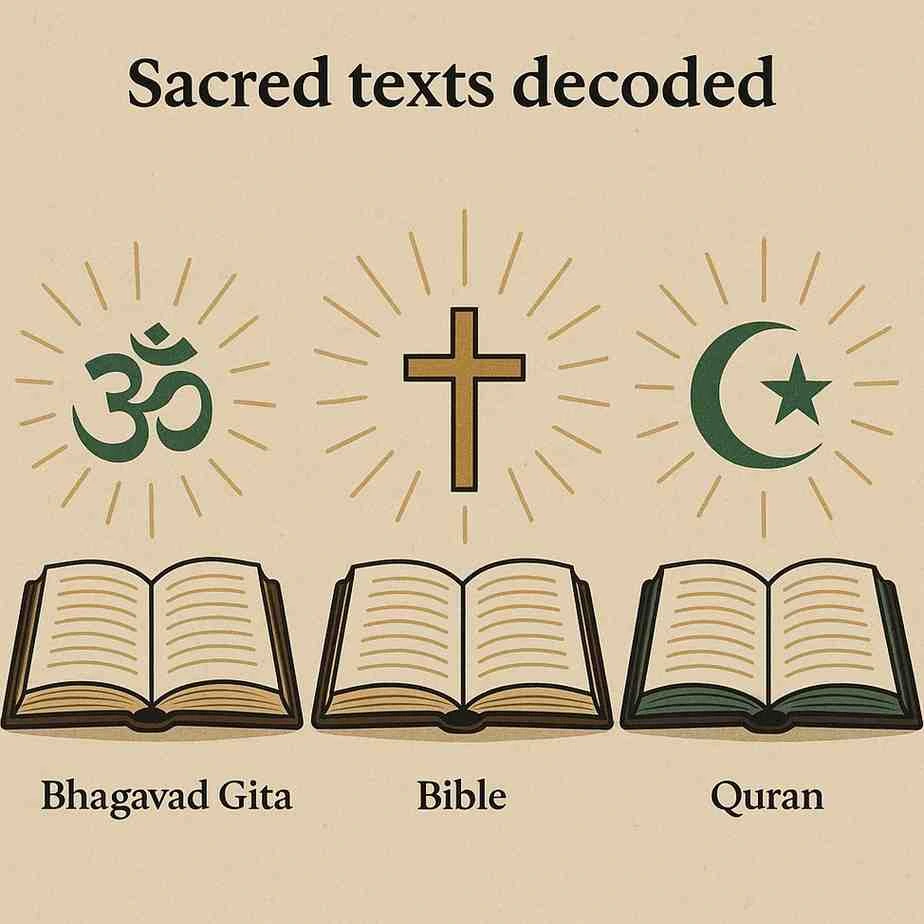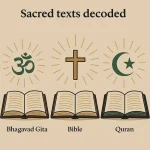Sacred Texts Decoded: A Comparative Exploration of the Bhagavad Gita, the Bible, and the Quran
Sacred texts have always shaped the moral, spiritual, and cultural landscapes of civilizations. Among the world’s most influential scriptures stand the Bhagavad Gita, the Bible, and the Quran—three texts that continue to inspire billions. While each belongs to a distinct religious tradition, their messages carry surprising overlaps, timeless wisdom, and unique philosophical perspectives. Understanding them side by side not only deepens spiritual insight but also builds bridges of respect across cultures.
1. Origins and Context
The Bhagavad Gita, a 700-verse dialogue within the Indian epic Mahabharata, unfolds on a battlefield where Prince Arjuna is torn between duty and emotion. Lord Krishna’s guidance to Arjuna becomes a universal spiritual manual, blending philosophy, ethics, and devotion.
The Bible is a compilation of many books written over centuries. The Old Testament contains history, poetry, and prophetic teachings of ancient Israel, while the New Testament centers on the life and message of Jesus Christ. Together, the Bible becomes the foundational text of Christianity, offering moral guidance, divine commandments, and narratives about human struggle and redemption.
The Quran, believed by Muslims to be the direct word of God revealed to Prophet Muhammad, is written in powerful, poetic Arabic. Its 114 chapters, or surahs, guide believers on faith, law, morality, and the relationship between humans and the Creator. The Quran emphasizes divine mercy, justice, and the path of righteous living.
2. Understanding the Divine
In the Bhagavad Gita, God is presented as the all-pervading, supreme consciousness. Krishna explains that the Divine resides within every being and that different paths—knowledge, devotion, and action—can lead to the same ultimate truth. God is both personal and cosmic.
In the Bible, God is a loving Creator who forms a covenant with humankind. The Christian understanding of God as Father, Son, and Holy Spirit emphasizes a relational aspect—God who cares, forgives, and seeks a personal bond with humanity.
The Quran describes God (Allah) as one, unique, and incomparable. Allah is merciful and just, closer to humans than their own lifeline. The Quran highlights absolute monotheism and encourages believers to surrender fully to God’s will.
3. Human Purpose and Duty
A central teaching of the Gita is dharma—one’s moral and spiritual duty. Krishna urges Arjuna to act without attachment to outcomes. The idea of karma yoga (selfless action) becomes a universal principle: perform righteous deeds, but stay detached from reward.
The Bible emphasizes living according to God’s commandments, loving one’s neighbor, and walking in faith. The life of Jesus becomes a model of compassion, sacrifice, and forgiveness, guiding Christians toward righteousness.
The Quran teaches humans to live justly, seek knowledge, uphold truth, and care for others. A believer’s duty is expressed through the Five Pillars of Islam—faith, prayer, charity, fasting, and pilgrimage—which create discipline and spiritual focus.
4. Morality and Ethical Living
Despite arising from different cultures, all three texts stress similar moral values.
The Gita prioritizes self-control, truthfulness, and inner discipline. It teaches that conquering one’s own mind is the key to liberation.
The Bible emphasizes forgiveness, humility, charity, and the sacredness of life. Its parables offer practical lessons on kindness and ethical behavior.
The Quran upholds justice, honesty, patience, and compassion. It warns against arrogance and encourages generosity toward the poor and oppressed.
These ethical teachings demonstrate that moral wisdom is universal, transcending time and geography.
5. Life, Death, and the Afterlife
The Bhagavad Gita views life as a continuous cycle of birth and rebirth. The soul is eternal, merely changing forms like clothes. Liberation (moksha) comes when one realizes the true nature of the self beyond the physical body.
The Bible teaches that earthly life is temporary and that faith leads to eternal life with God. Heaven and hell represent final destinations based on one’s relationship with God and moral choices.
The Quran describes detailed concepts of resurrection, judgment, paradise, and hell. The afterlife is a continuation of one’s earthly deeds, emphasizing moral accountability.
6. Paths to Spiritual Growth
Each text offers a distinct spiritual roadmap:
Gita: The paths of knowledge, devotion, meditation, and selfless action.
Bible: Faith in God, repentance, love, prayer, and following the teachings of Jesus.
Quran: Submission to God’s will, regular worship, charity, remembrance of God, and righteous deeds.
Though the methods differ, all aim at inner purification and closeness to the Divine.
Unity in Diversity
The Bhagavad Gita, the Bible, and the Quran are not just religious documents—they are timeless guides to human life. Each speaks in its own voice, shaped by its culture and era, yet all converge on shared ideals: morality, compassion, discipline, and the search for truth.
By decoding these sacred texts together, we discover not division, but a rich tapestry of wisdom, showing that humanity’s spiritual quests—though diverse—move toward the same horizon: understanding ourselves, our purpose, and the Divine.
~Religion World Bureau









